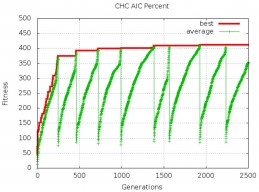Evolutionary computation offers flexibility, insight
August 4, 2011

Optimization of a search over subsets of a maximum model proceeds initially at a quick rate and then slowly continues to improve over time until it converges. The top curve (red) shows the optimum value found so far, while the lower, jagged line (green) shows the current average fitness value for the population in each generation (credit: Franklin University)
Esmail Bonakdarian, Ph.D., an assistant professor of Computing Sciences and Mathematics at Franklin University, has developed an evolutionary computation approach that allows researchers to search for models that can best explain experimental data derived from many types of applications, including economics.
Bonakdarian employed his evolutionary computation approach to analyze data from two well-known, classical “public goods” problems from economics: When goods are provided to a larger community without required individual contributions, it often results in “free-riding”; but people also tend to show a willingness to cooperate and sacrifice for the good of the group.
He cautioned that if the number of independent variables is large, and there is no intuitive sense about the possible relationship between these variables and the dependent variable, “the experimenter may have to go on an automated ‘fishing expedition’ to discover the important and relevant independent variables.”
As an alternative, Bonakdarian suggests using an evolutionary algorithm as a way to “evolve” the best minimal subset with the largest explanatory value.
“This approach offers more flexibility as the user can specify the exact search criteria on which to optimize the model,” he said. “The user can then examine a ranking of the top models found by the system. In addition to these measures, the algorithm can also be tuned to limit the number of variables in the final model. We believe that this ability to direct the search provides flexibility to the analyst and results in models that provide additional insights.”
The Glenn IBM 1350 Opteron cluster at the Ohio Supercomputer Center (OSC) was used for the project.
Ref.: Esmail Bonakdarian, The Use of Evolutionary Algorithms in the Analysis of Economics Experiments, The Proceedings of the 2011 International Conference of Genetic and Evolutionary Methods (GEM’11), 2011; [link]